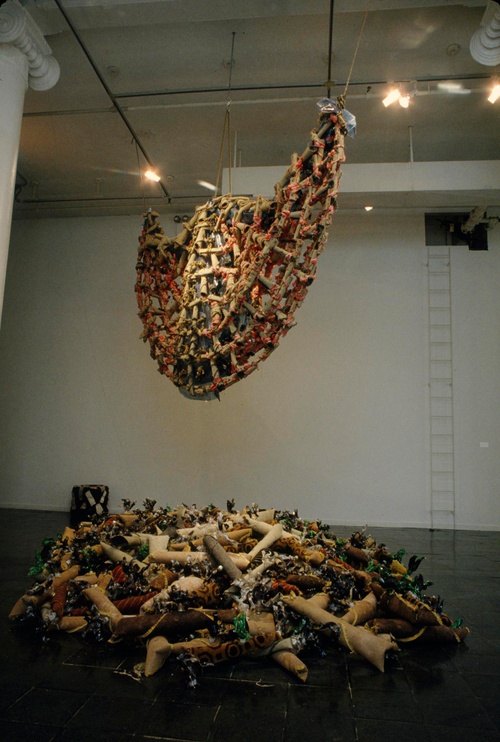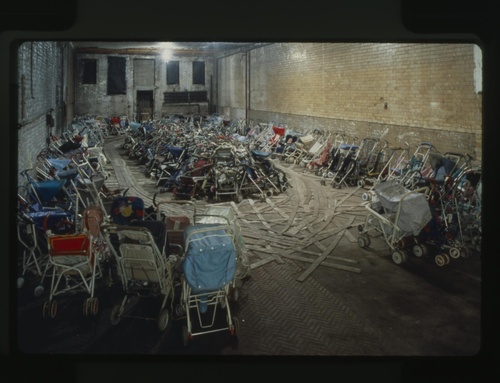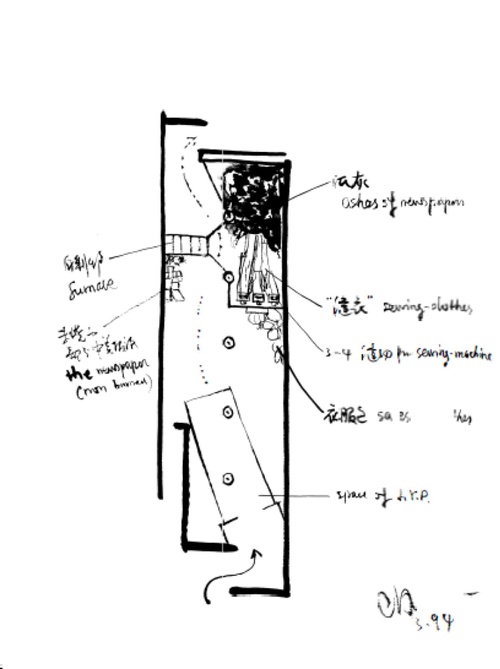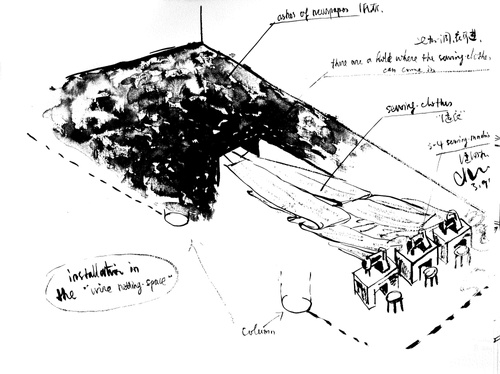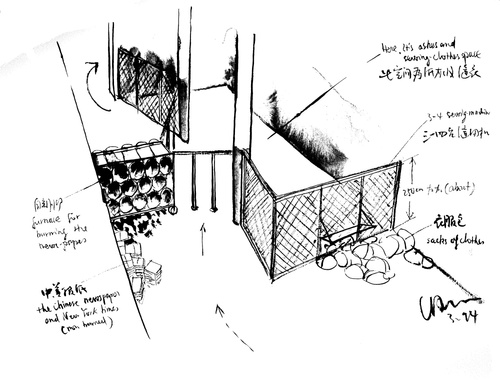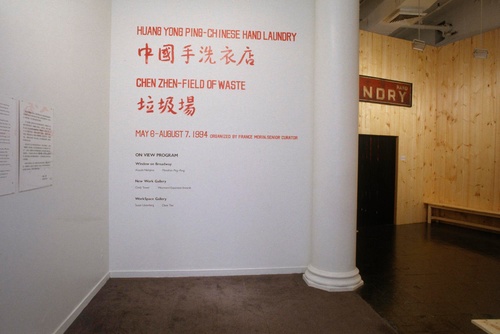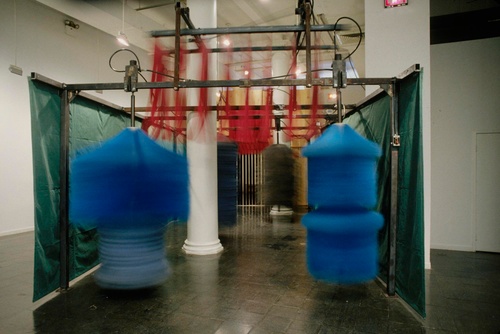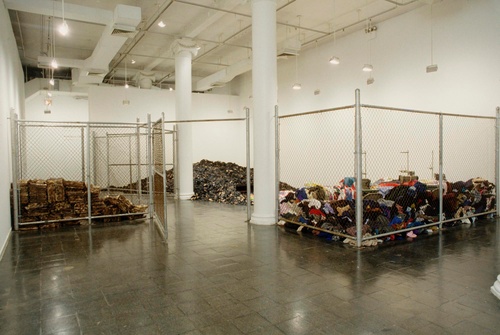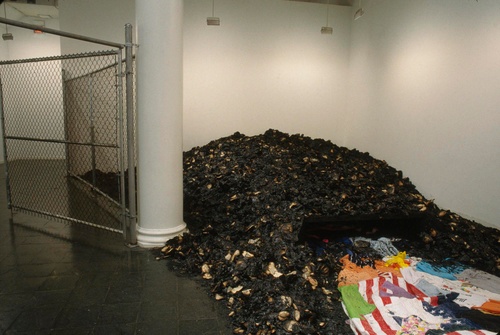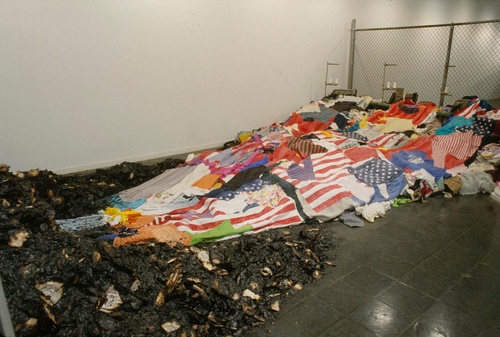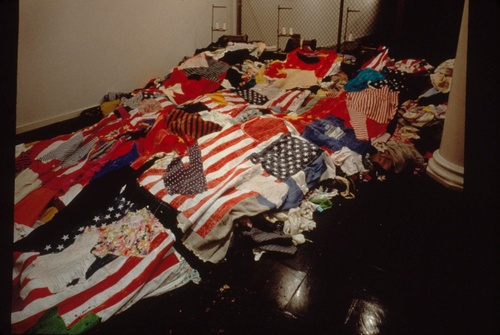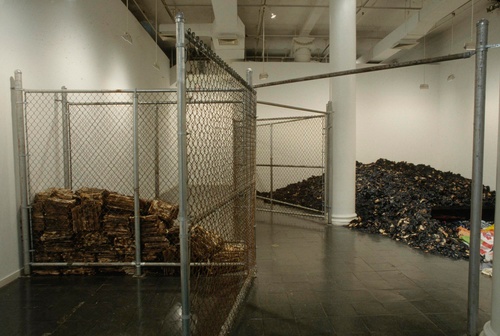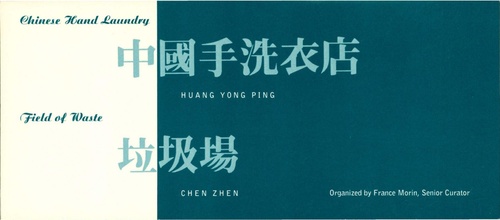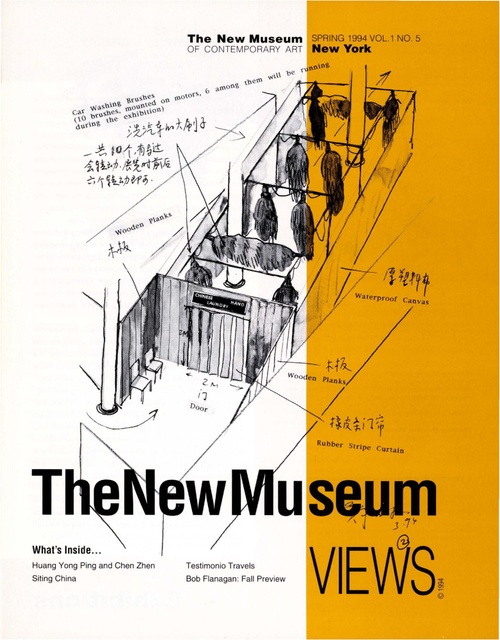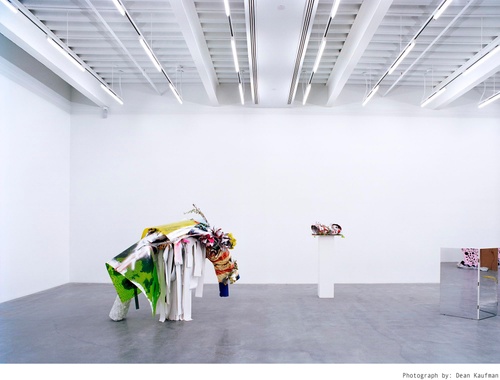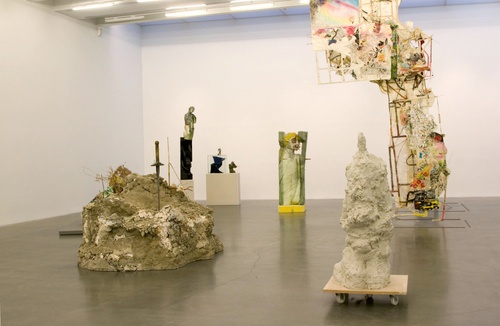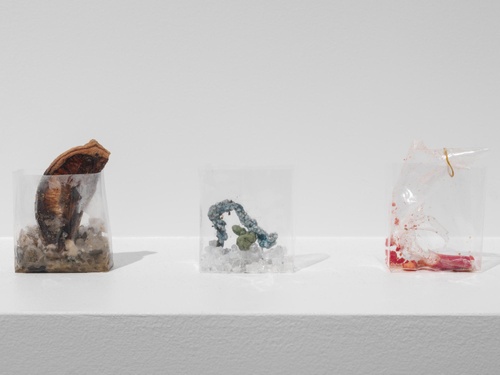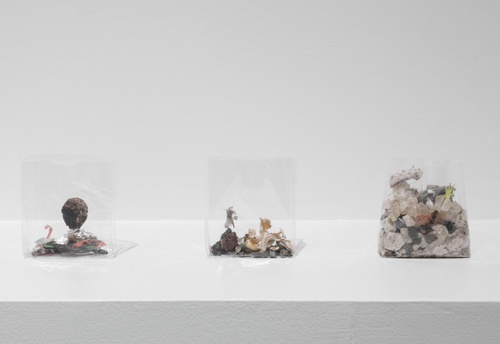Lost, Sought, Found: Activating Everyday Material in New Museum Exhibition History
ATLAS: Winter/Spring 2019
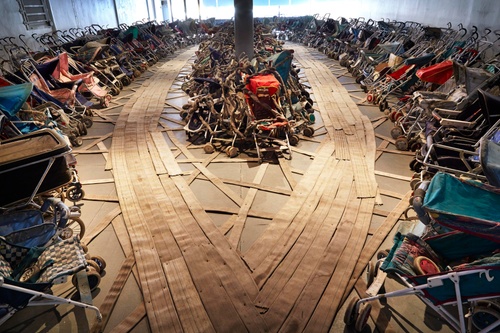
Nari Ward, Amazing Grace, 1993. Installation view: “NYC 1993: Experimental Jet Set, Trash and No Star,” New Museum, New York, 2013.
This multimedia essay explores the connections between the 2019 exhibition “Nari Ward: We The People” and archival material from the New Museum’s exhibition history through the framework of artists who engage with found material in their work. Exhibitions cited are: Nari Ward: We The People (2019), The Keeper (2016), NYC 1993: Experimental Jet Set, Trash and No Star (2013), Unmonumental: The Object in the 21st Century (2007), Chen Zhen: Field of Waste (1994) and Nari Ward: Carpet Angel (1993).
In 1993, Nari Ward was invited to show work at the New Museum for the first time. As part of his artist statement for the exhibition, he wrote, “Whether it’s firehoses, carpets, cotton, etc. or vessel forms like bottles and bags each material has a unique history which intrigues and informs my vision of their renewed possibilities. It is the energy and texture that is acquired through use that is of interest to me; their mutability, the history that they have gleaned through consumption; worn and discarded materials often found on the street are worked, knotted, drilled, ironed or wrung out to become charged with a devotional function and meaning.” 1
His 1993 installation of Carpet Angel (1992) hung in the New Work Gallery of the New Museum’s 583 Broadway location, a hulking, hovering mass born from the simple and readily at hand. The rolled carpets that form the ropey, netlike skin of the angel’s body and populate the garden of detritus underneath were sourced from the floor of Ward’s own Harlem studio, which he sublet from a fellow artist who had asked him to act as steward of the space and the paintings it housed. Ward, disliking the carpets, started to pull them up, and then decided to work them into a new piece rather than discard them outright.
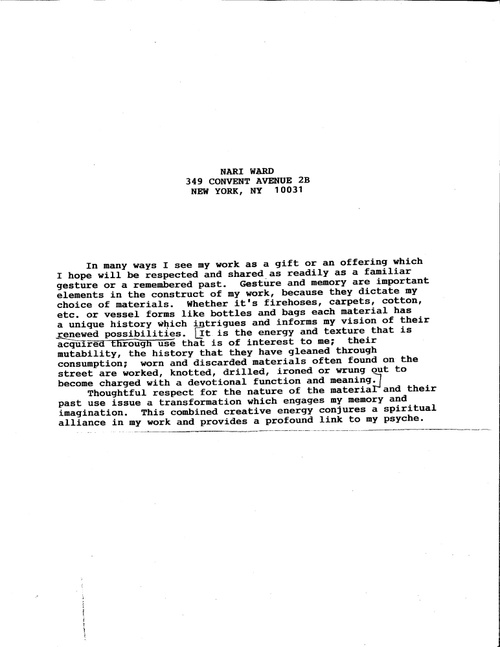
Nari Ward, unpublished artist statement, 1993
Nari Ward and Donald Moffett in conversation with Assistant Curator Helga Christoffersen for “Who’s Afraid of the New Now?: 40 Artist in Dialogue,” December 2, 2017. New Museum, New York.
The viscera of the angel’s body are a crumpled accordion of carpet runner; it rises from a landscape tangled with burned plastic bottles and knotted with plastic bodega bags. Not only do these materials conjure the hyper-local (the floor of Ward’s studio, the trash bins outside the building, the corner store), they are also hyper-pedestrian in the sense that their utilitarian value trumps any preexisting aesthetic content. In the case of the carpet runner, the material is even meant to be invisible in everyday use. “So-called ‘found objects,’” says Ward in an interview with MASS MoCA Director Joseph Thompson, “repurposed materials from other artists’ projects, personal history, art history, community history, etc., are all like the ‘once upon a time’ of a children’s story. They set the tone and start the conversation; my goal is to use these things to push the questions and formal issues into motion.” 2
The original exhibition brochure featured an essay from curatorial intern Mimi Young, who connected Ward’s specific use of media to his Jamaican heritage, considered his relationship to spirituality and religion through the lens of his Baptist upbringing, and linked the labor of cutting, rolling, and weaving in his work to African-American quilt-making from scrap fabric, a tradition that began during slavery. What Young’s essay and most contemporaneous reviews identified in Ward’s work was the way in which repurposed or found material had the ability to cross geographic and temporal boundaries. “By improvising with what is at hand,” wrote Young,
“and choosing to reconstitute unwanted material from the daily environment, Carpet Angel also functions as a mapping of the urban landscape and a reference to its decay. Living off the land, scavenging available materials, is as familiar to the homeless in urban America as it is to the shantytowns of Jamaica. Capitalism encourages ever-growing consumption in every aspect of life, privileging new over old, novelty over practicality. In contrast, Ward’s installation reinvests these waste products with new potential through the transcendence of impoverished media and the creation of a revelatory space.” 3
Ward’s use of what are commonly referred to as “found objects” as the central medium for his work is discursively linked to the history of twentieth-century Western modernism and postmodernism. The act of finding, choosing, or assembling utilitarian or discarded objects in the context of artistic practice or institutional display is at the heart of Marcel Duchamp’s readymades, Surrealist “object” sculpture, Arman’s Le Plein at Galerie Iris Clert (1960), Robert Rauschenberg’s combines, Joseph Cornell’s shadow boxes, postmodern pastiche, and even forms of collage, montage, and found footage in video art. Each of these art historical examples rationalizes the presence of the found object differently and mobilizes it to very different ends: the readymade’s calculating “indifference” and investment in industrial production stands apart from the subjective, psychically treasured, unconscious-raising Surrealist furry teacup, antique spoon, or revelatory flea market find. 4
Common threads do exist, however. The use of found material generally succeeds in bringing the planes of art and everyday life together, requiring the viewer to consider the value of a banal or discarded object within the context of an artist’s studio, a gallery, or a museum. Found objects also partake in a conversation about commodities and economies. They reference local or global circulation; repurposing as a means of survival; or scarcity, excess, and built-in obsolescence as conditions of capitalism. Whether the artist (or viewer) perceives the found object as waste, salvage, outmoded, bartered, or purchased can drastically alter the context of its interpretation and its ontological significance.
But regardless of what -ism has been associated with found material since André Breton’s “discovery” of the Cinderella ashtray,5 there is a consistent assumption about the significance of the use of this medium: that the artist in incorporating it has somehow recuperated, reactivated, or rescued the chosen material from an inevitable death of obsolescence, a present or future uselessness caused by its falling out of the circulation of capital and commodities. There is a Benjaminian romanticism sometimes assigned to this view of the ragpicker-artist, a view that deliberately overlooks the reality that the found material is not only rescued by having artistic value reinscribed onto it through the act of becoming part of an artwork but also, necessarily, new commodity value.
Because of its previous (or ongoing) life as a viable commodity, the found object has an almost tangible memory-resonance. It bears traces of use, of its owner—of multiple uses and multiple owners—and sometimes traces of its own fall from grace into the rubbish heap. Details like brand names and extent of use gesture to specific neighborhoods, economic classes, and times; found material can thus be pseudo-archival and pseudo-archeological in its ability to signal to life and community. It can be, depending on its use and deployment, elegantly metonymic: discarded clothes stand in for absent bodies, old tools for labor, architectural and industrial fragments for whole buildings.
For Ward, the fragmented and “junkyard” aspect of found objects is one of their more generative qualities. “I like the idea that these things that were considered useless and discarded can become special,” he says in the exhibition catalogue for his 2015 Pérez Art Museum Miami exhibition, “Sun Splashed.” “That’s why, for me, it’s about finding distressed objects. I’m already starting with this thing that’s kind of low. It’s this thing at the end of its life. How do you activate it, how do you energize it, how do you make it shine again?” 6 Ward’s contribution to the recuperation of these objects is not just selection, then, but physical alterations coupled with a serious contemplation about their history and form. The act of inscribing his own traces into the found material or binding different forms together has, as he says, a devotional aspect. Rituals of rolling, burning, wrapping, or nailing come from a desire to see these objects “energized” in a way that speaks as much to a potentially hopeful, spiritual future as it does to a painful past. Ward’s laborious interaction with found objects is an essential part of his artistic practice, and one that differentiates his version of the found object from the “disinterested” and wryly selected readymade. To take the time and care to reintegrate these discarded objects into a new form is to give them a new narrative, and in such a way that asks viewers to reconsider the way they have engaged—or not—with similar everyday objects outside the context of the museum.
Following his first exhibition of Carpet Angel at the New Museum in 1993, Ward went on to install what is perhaps his best-known work in an abandoned fire station on Harlem’s West 141st Street. He initially hoped to have Amazing Grace (1993) installed in a church, but ultimately created a sacrosanct atmosphere from the specific arrangement and form of the found objects he installed, rather than the architectural space. Amazing Grace comprised 365 empty baby strollers that Ward had collected from around the neighborhood in the preceding year, while he was in residence at the Studio Museum in Harlem. Arranged in a double-teardrop of tightly huddled congregations, the strollers were wrapped with firehoses salvaged from the abandoned space. A recording of Mahalia Jackson performing the eponymous gospel song played on a loop.
Ward’s realization of this work (which was also installed at the New Museum in 2013 for the exhibition “NYC 1993: Experimental Jet Star, Trash and No Star”) began with a lone encounter with a single abandoned baby stroller. “I remember the moment,” he recounted to former MOCA Los Angeles director Philippe Vergne:
“I was walking down 125th street during eight a.m. rush hour. I’m at Lexington Avenue, right near Park Avenue. There’s a Metro North station there, so a lot of people are going in, commuters; there’s a lot of flux and movement. I remember seeing, in all this energy and movement of people trying to get to where they’re going on schedule, this baby stroller with bottles and cans next to a chain-link fence. That moment of this beat-up stroller with all this movement around it really struck me—something interested was going on there. This emptiness was something really visceral. But nobody was looking at it, nobody was seeing it. I just needed more. I needed to collect more of them so people could see it.”7
Two key concepts emerge from Ward’s relationship to this particular found object. One is the sense that the abandoned baby stroller immediately conjures up deep loss and loneliness—a result of the combination of the stroller’s original intended emotional status and utility (family, children, parental love) and its transformation into a discarded afterthought (estrangement, lost connections, fracturing of family). The object also speaks directly to the social and economic reality of Harlem in the late 1980s and early 1990s, where homeless members of the community often toted their belongings along the streets in repurposed shopping carts, suitcases, and strollers. As Diana Nawi notes, Ward’s work from that period confronted the fact that “large parts of this neighborhood were ravaged by social and economic blight, as were many inner-city neighborhoods across the country. Ward’s practice of using refuse and the detritus of the streets, artifacts of the everyday realities of duress, emerged from a need to respond in a real way to this landscape of trauma.” 8
The second key component of Amazing Grace is Ward’s recognition that volume, the act of aggregation and amassing, was required to transform viewers’ relationships to found objects. A single abandoned stroller on a New York sidewalk may not always catch someone’s eye, but recontextualized within the walls of a museum, gallery, or otherwise dedicated space along hundreds of others of its kind, the stroller takes on a kind of anthropomorphic agency, demanding recognition and empathetic response.
The conditions of Ward’s found object work—the chance encounter, ritual labor, and accessing the emotional, economic, or social lives of commodity material—are echoed in the work of several other artists exhibited at the New Museum throughout the past twenty-five years. These artists’ engagements with found objects demonstrate the enduring ability of rescued commodities and recovered waste to speak to issues of immigration and diasporic identity, global economies, and capitalism’s obsession with over-consumption and obsolescence.
Chen Zhen, “Field of Waste” (1994)

Above: Chen Zhen, Field of Waste. Installation view: Huang Yong Ping, “Chinese Hand Laundry” and Chen Zhen, “Field of Waste,” New Museum of Contemporary Art, 1994. Sound: Curators France Morin and Alice Yang discuss the sourcing of materials for Chen Zhen’s Field of Waste installation in the gallery talk “Up in Flames: The Art of Huang Yong Ping and Chen Zhen,” May 14, 1994.
When New Museum curator France Morin began planning the joint exhibition of Chinese artists Huang Yong Ping and Chen Zhen in the spring of 1994, Chen mentioned that one of his installation needs would be a space in which to burn large quantities of newspaper (both the New York Times and several selections from local Chinese-American publications). Because Nari Ward was still in close contact with New Museum staff, Morin asked Ward whether he would mind sharing his Harlem space with Chen for the duration of Chen and Huang’s month-long residency in New York, as Ward was currently in the process of making work that featured large quantities of burned baseball bats. 9 Brought together by their common act of burning salvaged material—by the need to accumulate volume and then alter the objects in order to reactivate them—the two artists embarked upon a cooperative studio experience that launched a long friendship and several artistic collaborations.
While Huang eventually realized an ambitious project entitled “Chinese Hand Laundry,” which recreated a human-scaled car wash inside the gallery space, Chen’s installation, “Field of Waste,” used more pedestrian and less industrial material: ash from the burned newspapers, bundles of whole untouched newspapers, yards of sewn cloth, sewing machines, and chain-link fences. Both projects pointed to the artists’ own experiences of dislocation from their homeland (Chen and Huang both left China in the mid-1980s to live in Paris) and sought to understand something of the specificity of the Chinese-American immigrant experience.
In order to access Chen’s “Field of Waste,” a museum visitor had to first go through Huang’s installation, which equated the visitor’s physical passage through the work—making contact with the spinning brushes, barely ducking under the swaying felt straps—with a kind of “spiritual cleansing.” 10 At the far end, the exhibition opened up onto a long room where Chen had installed a network of chain-link fences, creating divisions in the space that recalled abandoned lots, back alleys, or—more grimly—something approximating the barricades used to funnel and corral human bodies in bureaucratic transfer spaces (the DMV, customs and immigration, etc.).
Piled tightly in the leftmost enclosure were the bundles of unaltered newspaper, still wrapped with twine. On the other side of the gallery, Chen installed three sewing machines with metal chairs tucked up against their workspaces, each frozen in the act of chewing up and spitting out yards of salvaged cloth, used T-shirts, and rags interspersed with US and Chinese flags. The river of cloth extended down the entire length of the enclosure, at the end of which it was engulfed by the heap of charred newspaper remnants. An Art in America review noted the scent of sludgy ash hanging in the air, while Holland Cotter likened the experience of the space to a “bad-dream sweatshop” in his review for the New York Times. 11
In his initial project proposal for the New Museum, Chen wrote,
“New York is an ethnic mosaic, where the myth still holds true… . Both Huang Yong Ping and I share an interest in current concerns such as wealth and poverty, racism, immigration, material life vs. spiritual life, multiculturalism, and ideological differences… . “A Field of Waste Disposal’ will be built up in two processes: burning and sewing. The first is a usual political and cultural ‘revolutionary means’ in Chinese history, while the latter is one of the essential ways for Chinese immigrants to survive abroad. Burning is destruction while sewing fabrication. However, in this project, by putting these two extremes together, matters will be at the same time ‘neutralized’ and ‘chaoticized.’” 12
Here, Chen identified that in his work, the labor associated with each found material is as important as the material itself. The act of burning is posited as “revolutionary” in a political sense, but also—as Morin notes in her exhibition text—in a spiritual sense that is rooted in Taoist cosmology, where burning signifies purification and transformation. With the juxtaposition of burning and sewing as forms of labor-oriented interaction with found material, Chen “combined two processes to produce a field of symbiotic and coexisting identities,” a notion furthered by the yards of gathered and sewn-up flags, clothing, and scrap fabric, and by the patchwork of (national and individual) identities they implied.
Chen Zhen: Field of Waste
In an additional piece of gallery text, assistant curator Alice Yang focused on how the concepts of creation and destruction also speak to consumption cycles within capitalism. “If the sewing machines themselves signify a particular form of labor and production,” Yang wrote, “then on one level, the ashes stand for waste—for the residues of consumption.” 13 In this sense, Chen’s installation broadly parallels Ward’s interest in the recovery of obsolescent material, but Chen goes so far as to recover and activate within the museum the productive object of labor (the sewing machine), the object produced (the sewn cloth, the newspaper bundles), and the wasted remnants of the object (the ashes of burned newsprint).
More specific to Chen’s installation, the status of “pure” production—the actual labor of sewing divorced from para-production such as design and marketing—sites the sewing machines and the yards of salvaged cloth firmly within the locality of New York’s Chinatown in the 1990s. “Chinatown,” Yang wrote, quoting a piece of investigative journalism,
“doesn’t design, cut, or market. It only sews… . The sewing of seams, the cutting of threads, the stitching of buttonholes, one after another, all day long. This labor feeds into the cycle of production that makes up the multi-billion dollar fashion industry in New York. This labor is also the main means of livelihood for many who immigrate to America in search of a new life.” 14
Shinique Smith: Bales and Bundles (“Unmonumental,” 2007)

Above: Shinique Smith, Their First Bundle, 2004. Sound: Curator Laura Hoptman, introducing the audio guide for “Unmonumental: The Object in the 21st Century” (2007)
The exhibition “Unmonumental: The Object in the 21st Century” was the first to open in the New Museum’s 235 Bowery building, toward the end of 2007. Co-organized by Senior Curator Laura Hoptman, Kraus Family Curator Massimiliano Gioni and Chief Curator Richard Flood, the exhibition surveyed the conditions of contemporary sculpture that emerged from an “attitude” that was anti-masterpiece and anti-environmental. Instead, the curators put forth a “fluid definition of sculpture that understands itself not as a self-sufficient, complete form but rather as a receptacle, an intersection of disparate materials and images.” 15
Because, as Gioni argued, “today’s sculpture seems to be less engaged in interrogating its own status than it is overexcited by the idea of annexing the whole world to its own body,” 16 a significant selection of the sculptural works featured in the exhibition took found objects, waste, and “second-hand images” as their foundational material. The Museum’s new galleries were filled with artwork that combined unadorned and undisguised architectural fragments, furniture, cardboard, yarn, appliances, clothing, and everyday knickknacks in ways that deliberately lacked the qualities of the monumental sculpture: “massiveness, timelessness, and public significance.” 17 Instead, Hoptman argued that the collection of these sculptures made the contingent primary in a way that was at once “personalized to a level unprecedented in recent sculptural memory” and yet “most intentionally un-private.” 18
On a more concrete level, this meant that while certain artists featured in the exhibition created work that may have had its origins in a subjective connection to a certain found material, the resulting significance, interpretations, or polemics could speak to broader societal or political concerns. Shinique Smith, for example, connected her choice of media—found articles of clothing, accessories, and binding agents such as twine, rope, and ribbon—to a space of memory, seeking to mine the “same sort of sense of discovery that [she] had as a little girl.” 19 For Smith, the operations of this discovery and nonmonetary exchange were at the source of her material, whether it was a scarf found hanging on a New York City park fence or a T-shirt gifted to her by a loved one.
Smith made her “bales” and “bundles”—sculptures she also sometimes referred to as “conglomerates”—by collecting various found and gifted clothing items and accessories, often guided by a process that she calls “found color.” 20 From there, a meditative act of binding pulled the found material into shape, resulting in geometric blocks or spheres that varied significantly in scale. “The flow of the city, compacted bales of refuse, fashion, and urban architecture inspire my work,” she wrote in a 2006 artist statement. “Made of fabric, accessories, clothing and bed linen, the process used to make my bound sculptures is meditative and ritualistic. Tied, and wrapped with force and consideration of pattern, color, texture, and form, my sculptural and wall works appear as minimal chunks, or conglomerate, organic forms that exist on their own or interact with the architectural elements that surround them.” 21
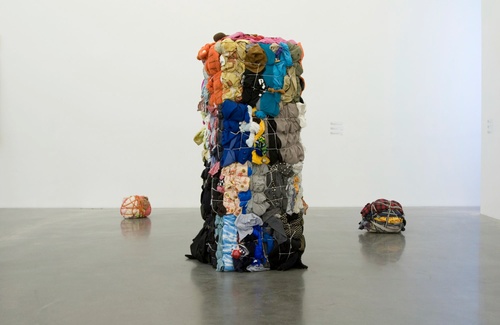
Left to right: Shinique Smith, Louise Bundle, 2006, Bale Variant Number 0011, 2005, and Their First Bundle, 2004. Fabric, clothing, twine, wood, carpet, and ribbon. Courtesy the artist. Installation view: “Unmonumental: The Object in the 21st Century,” New Museum, New York, 2007.

Shinique Smith, Their First Bundle, 2004. Fabric, clothing, and ribbon, 18" in diameter. Courtesy the artist. Installation view: “Unmonumental: The Object in the 21st Century,” New Museum, New York, 2007.
Abraham Cruzvillegas, Gedi Sibony, and Shinique Smith discuss “Unmonumental: The Object in the 21st Century,“ December 13, 2007, New Museum, New York.
Smith’s finished works have the appearance of geological strata, an overstuffed closet, compacted shipping pallets, or even restrained flesh, bulging out between the tightly pulled grids of twine. The smaller ovoid bundles are scaled to the human body, giving off the sensation of a hastily packed group of possessions that could be easily picked up and carried or tossed into the back of a moving truck. The larger bale-shaped sculptures are more imposing; they shift between a formal, almost painterly attention to color and texture and the visceral reality of the pure volume of accumulated, discarded, and recovered “stuff.”
In 2007, the “Unmonumental” curators and Smith herself connected the works to the practice of shipping enormous quantities of used clothing from America to developing nations. Smith’s bale and bundle forms deliberately echo the compressed pallets of corporate logo T-shirts and unused Superbowl paraphernalia that is part of a $550 million–dollar trade network where American nonprofits regularly ship a billion-plus pounds of used clothing overseas, clothing that is deemed below domestic standards for resale within America. 22 “This is a form of sculpture,” wrote Gioni, “that is concerned with its place in the world, with the amount of space it can take over in a civilization that is already overcrowded with goods, commodities, and waste. It is an art of recycling that suggests a universe on the verge of being completely overtaken by refuse. The fact that this kind of sculpture is mostly practiced in Europe and in America is also a signal that this aesthetic gathers its inspiration from an affluent society that appears to be tired, almost exhausted, or possibly just decadent.”23
Over a decade later, Smith’s works in “Unmonumental” take on added signification as global networks—and the cycles of used, discarded, abandoned, and rescued clothing that move through them—shift. As much as her “failed monuments” still reference the global trade of commodities and an overabundance of cheaply made products, they also speak to the crisis of migrants and refugees forced from their homes by violence and economic precarity. Her little bundles, with their assumed portability, might contain that which can be salvaged and carried across roads, rivers, and dangerous ocean crossings, while the dauntingly large Bale Variants feel increasingly like memorials to “what is lost along the way.” 24
Yuji Agematsu: Okimono (“The Keeper,” 2016)
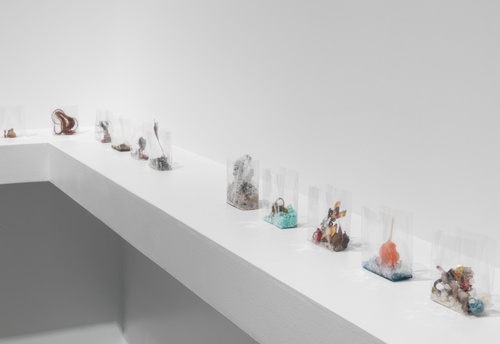
Above: Yuji Agematsu, detail of 01-01-2014 – 12-31-2014 (01-01-14 – 02-29-14) Installation view: “The Keeper,” New Museum, New York, 2016. Photo: Maris Hutchinson / EPW Studio. Sound: Edlis Neeson Artistic Director Massimiliano Gioni introducing the audio guide for “The Keeper.”
In Japanese, the term okimono [置物 “placed object”] describes small, decorative objects that are usually part of altar displays or traditional domestic alcoves known as tokonoma [床の間]. They can be made from carved wood, porcelain, metal, or ivory, and serve no utilitarian purpose beyond the social utility of aesthetic appeal, demonstration of craft, and connection to religious or social morality and mythology. The word is a combination of the verb oku [置く“to put,” “to place,” “to set down”] and the noun mono [物 “thing,” “object”].
Yuji Agematsu, who was born in Kanagawa, Japan, but moved to New York as a young man in 1980, works directly with the concept of okimono, linking it with the artistic practice of found media. Like that of Ward and Smith, Agematsu’s work is the result of ritual labor, chance encounters, and the careful consideration of any given object’s color, size, and presence. The rituals underpinning Agematsu’s practice are twofold: his daily and meticulously documented walks in specific New York City neighborhoods and the scavenging and collecting of detritus that he finds on the street along the way. The walks can be meandering or they can span only a few square blocks of Manhattan’s grid; regardless of their complexity, Agematsu records them all, along with the time and date, in a series of small notebooks. The found material that he discovers and selects along his walks tends toward the waste remnant: a wad of chewing gum, a pigeon feather, a curly tangle of twine, a sticky label, cigarette butts. Each walk and its discoveries are catalogued through a system of arranging street waste and either pinning it to a board (like a lepidopterist of trash) or, more frequently, displaying it in the tiny rectangles of cellophane used to wrap cigarette packages.
The New Museum’s 2016 exhibition “The Keeper” featured a selection of these delicate urban terrariums, representing two months of seeking and gathering (from the beginning of January to the end of February 2014). Agematsu translates his geographic mapping of the city into the character of each cellophane universe; he documents the temporal mapping of his ritual artistic practice through the steady aggregation and systemic organization of each packet as a necessary part of a whole. The result is a body of work that is simultaneously humorous and sincere, pseudoscientific and almost magically alchemic in its ability to transform abject bits of city grime into small, glittering treasures. The meticulous care and consideration Agematsu gives to an unidentifiable spiral of plastic recalls Ward’s encounter with the abandoned baby stroller, while Agematsu’s ritual acts of repeated labor (walking, documenting, selecting, organizing) echo the labor rituals of Chen and Smith (burning, wrapping) that serve as integral artistic contributions to the recovery of the found object.
Like Ward, Chen, and Smith, Agematsu’s work with found material is highly dependent on the volume of its accumulation. The temporal and geographic lives of these found objects accrue more significance the more of them there are, as if being part of a crowd identifies each as startlingly distinct and singular. Agematsu, in calling his pieces “accidental objects” and “already consumed,” also reveals why their uniqueness is a key part of his practice: “In my cigarette cellophane pieces, each piece is so singular, and the content is similar. Singularity attracts me. Each is made daily. And every day has its own differences. Each day is different from the last. And so is each work.” 25
In the didactic texts for “The Keeper,” the curators focused on the simplicity of Agematsu’s practice, which is founded on the most basic “ways to harvest, preserve, and transform materials, objects, and images that are freely available as part of our everyday surroundings.” 26 However, the apparent simplicity of his actions disguises a far more complex set of relationships that we as everyday users have to the remnants he collects. The pieces of trash that make up Agematsu’s miniature universes are a cartography of urban space and a calendar of his personal marked time, but also a record of the longer pseudo-archaeological time of urban decay, breadcrumb traces of commodity circulation and waste, and a petri dish of embodied human presence. “Hair, gum, and cigarettes, they’re human, you know,” said Agematsu in 2014. “They carry DNA. You can read them, or I can, a little. Each piece indicates some psychology of the chewer. Like down on Wall Street, all the gum is so tiny, so chewed down, you know, it’s really hard, and then around playgrounds and Times Square you can find huge suckers, real fat pieces.” 27
In saving and recontextualizing the deeply abject—those pieces of trash that threaten the even the most basic concept of “object” in “found object”—Agematsu further transforms the notion of value that circulates around all artistic work made from found material. Preserving the most aesthetically ruined and economically valueless implies that these pieces of detritus are “worth” saving, that they have value beyond the monetary. Agematsu’s urban scavenging ritual evokes the image of sifting through the aftermath of a disaster for fragments of a past life, searching for torn scraps of family photographs or shards of furniture as physical evidence of existence. In this sense, his slow, meticulous archaeological work quietly posits that our everyday consumption of objects is equal to a mostly invisible urban ruin, a slow disaster unfolding around us in increments. Agematsu trails behind, saving what he can.
“Nari Ward: We The People” (2019)

Nari Ward, Amazing Grace, 1993. Installation view: “NYC 1993: Experimental Jet Set, Trash and No Star,” New Museum, New York, 2013.
In 1992, former Guggenheim curator Diane Waldman traced the history of the Western art historical use of found material and everyday objects in the exhibition “Collage, Assemblage, and the Found Object” and its accompanying publication. In it, she claimed that by the early 1990s, “consumer goods no longer excite as they did in the heyday of Pop art. They may titillate, but they do not shock or provoke.” 28 Waldman noticed that in contrast to the shock-value of Duchamp’s Fountain (1917) or the cheeky novelty of Warhol’s brand appropriation, “many of the artists working in the 1980s and 1990s have responded to an object-laden world by pointing out its excesses… . The object per se has lost its power to captivate, and seldom does it transcend its objectness. Its mere presence, however, tells us something about ourselves, our world, and our art.”29
More than a decade later, art historian W.J.T. Mitchell’s What Do Pictures Want?: The Lives and Loves of Images took on this history again and found it increasingly difficult to pin down in the late postmodern moment. Pondering the lack of a coherent and universal theory of objets trouvés, Mitchell posits that it may be precisely because “found objects themselves … haven’t felt the need for one”:
Everyone knows that there are just two criteria for a found object: (1) it must be ordinary, unimportant, neglected, and (until its finding) overlooked; it cannot be beautiful, sublime, wonderful, astonishing, or remarkable in any obvious way, or it would have already been singled out, and therefore would not be a good candidate for ‘finding’; and (2) its finding must be accidental, not deliberate or planned… . The secret of the found object is thus the most intractable kind: it is hidden in plain sight.” 30
But by defining the limits of the found object, Mitchell acknowledges the inherent hyper-specificity of the categorization, as well as how contemporary art has often refused those strictures. What about, he asks, the “sought object, the desired object, the sublime or beautiful object, the valued object, the aesthetic object, the produced, consumed, or exchanged object, the given or taken object, the symbolic object, the feared or hated object, the good or bad object, the lost or vanishing object”—if these are not found objects, what are they? 31
A decade following Mitchell’s book, Nari Ward’s retrospective further reframes the potential of the found object as something beyond the ordinary and accidental, beyond a reference to the overabundance of consumer culture—though it may still do that, too. Rather than rely on the readymade to shock, Ward leans into the rituals of labor to transform, combine, and resituate found materials into objects intended for contemplation. Found material, for Ward, can be as accidental as the discovery of the first baby stroller or as specifically sought out as the baseball bats and cotton balls in some of his works. The expansive nature of what constitutes found material in Ward’s work allows for an elasticity of space where viewer and artwork meet.
In more recent years, Ward has even begun reclaiming and repurposing language, treating it as a found material in its own right. One of his first sculptures incorporating “found” text was APOLLO/POLL (2017), part of his site-specific exhibition “G.O.A.T., again” at Socrates Sculpture Park in Queens, in which he recreated the iconic vertical segment of Harlem’s Apollo Theater sign. In Ward’s version, the neon of the “A” and final “O” intermittently flash on and off, creating a visual oscillation and connection between the words “APOLLO” and “POLL.” Created in the months following the 2016 presidential election, Ward’s sculpture nestles one politically loaded word into the heart of another, a word that gains its meaning and recognition as an iconic theater space (and not the Greek god) from the form in which it appears. The blinking of the sign creates an unmistakable connection between politics and community, between spaces of political voice and theatrical voice, and between political anger and the classic spectacle and judgment of an open mic night.
In Ward’s We the People—first created in 2011 for the Fabric Workshop and Museum in Philadelphia—the idea of language as a kind of object ripe for reclaiming and resituating is even more robust. The installation, which Ward has since recreated in additional permanent variations for the New-York Historical Society (2011) and Crystal Bridges Museum of American Art (2015), consists of thousands of repurposed and hand-dyed shoelaces threaded through a gallery wall in the shape of the three opening words of the Preamble to the United States Constitution. The phrase “We the People” is so iconic within American life and politics that it often functions as a gestalt object in its own right, offering a metonymic shorthand for the legacy of modern Western democracy. The phrase conveys a set of values and a sense of history, or histories; it conjures emotional reactions and imagery that, if not interrogated, take for granted assumptions about the meanings of “we” and “people.” In fact, the concrete “objectness” of the phrase acts as a bulwark against its own dissolution. As a symbolic utterance, it easily resists the kind of dissection—who is “we”? Who are “the people”?—that might allow for recognition of the trauma, exclusion, violence, and pain that would threaten its more lofty associations.
Ward requires We the People to be installed communally, with groups of local students or volunteers threading the shoelaces together. Taken alongside the variety of shapes and colors of the thousands of shoelaces, the participatory nature of the work deliberately points to the multiplicity of individuals that comprise “the people,” those protected by the language of the Constitution and its evolving meaning over the centuries. The act of “rewriting” the Preamble through a communal act comprising thousands of small, individual actions breaks apart the symbolic monolith of the Preamble’s “objectness” and then builds it back up again on the terms of the gathered participants. Through the creation of a new whole from an accumulation of discrete parts—not unlike the accumulation of baby strollers in Amazing Grace—the viewer is encouraged to reevaluate their relationship to the potential meanings of “We the People” and the everyday found objects that bind the words together.
Maggie Mustard, Ph.D. Marcia Tucker Senior Research Fellow, New Museum of Contemporary Art Published February 11, 2019.
-
Nari Ward, “Artist Statement,” 1993.
-
“Interview, Nari Ward speaks with MASS MoCA Director Joseph Thompson,” in Nari Ward: Sub Mirage Lignum, exhibition catalogue (North Adams, MA: MASS MoCA, 2011).
-
Mimi Young, “Nari Ward,” in Andrea Zittel, Kazumi Tanaka, Nari Ward, exhibition brochure (New York: New Museum, 1993).
, 1993Andrea Zittel, Kazumi Tanaka, Nari Ward
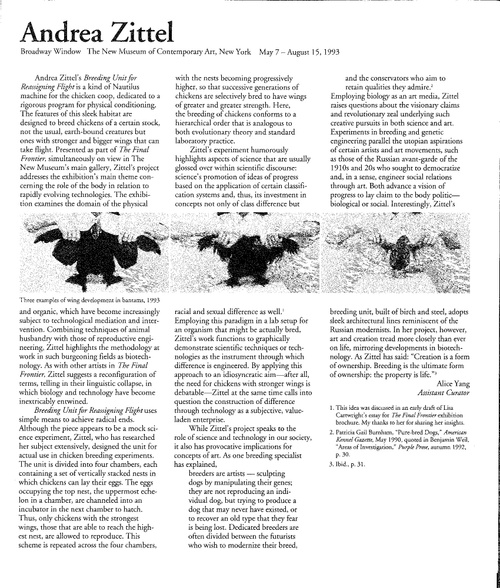
-
Margaret Iversen, “Readymade, Found Object, Photograph,” Art Journal 63, no. 2 (Summer 2004): 50. “While the readymade is essentially indifferent, multiple, and mass-produced, the [Surrealist] found object is essentially singular or irreplaceable, and both lost and found.”
-
In the late 1930s, Surrealist artist André Breton became fixated on a seemingly random phrase, cendrier Cendrillon [Cinderella ashtray], as a result of plumbing the unconscious through automatic writing. After stumbling on a small wooden spoon with a unique boot-shaped handle at a Paris flea market, Breton retroactively understood that this spoon was the realization of the “Cinderella ashtray” he had dreamt up. He had not gone looking for this specific object or even one that fit the strange name. Instead, in rows of object-laden stalls of the flea market, the correct object had, in some way, found him. See André Breton, Mad Love, trans. Mary Ann Caws (Lincoln: University of Nebraska Press, 1988), 29–34.
-
Philippe Vergne, “It’s OK to Disagree: A Conversation with Nari Ward,” in Nari Ward: Sun Splashed (New York: DelMonico Books/Prestel, 2015), 73.
-
Vergne, “It’s OK to Disagree,” 65–67.
-
Diana Nawi, “Being in the World,” in Nari Ward: Sun Splashed, 16.
-
“Who’s Afraid of the New Now?: 40 Artists in Dialogue: Donald Moffett & Nari Ward” (conversation, New Museum, New York, December 2, 2017).
, December 2 2017Who’s Afraid of the New Now?: Donald Moffett & Nari Ward
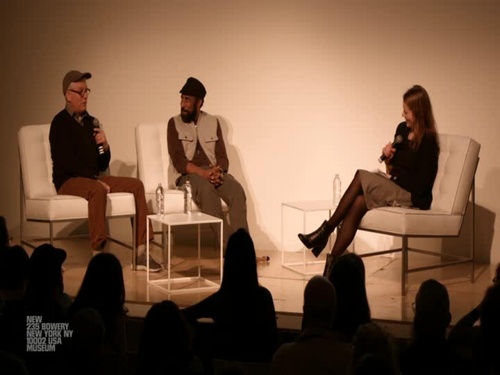
-
France Morin, “Chinese Hand Laundry and Field of Waste,” exhibition brochure (New York: New Museum, 1994).
, 1994“Chinese Hand Laundry” and “Field of Waste”
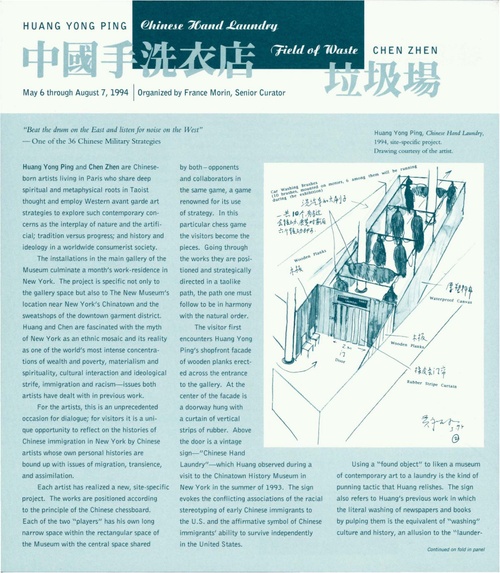
-
Janet Koplos, “Huang Yong Ping and Chen Zhen at the New Museum,” Art in America 83, no. 1 (January 1995): 104; Holland Cotter, “Art in Review: Huang Yong Ping and Chen Zhen,” New York Times, May 20, 1994.
-
Chen Zhen, “Chen Zhen: A Field of Waste Disposal (Project for New Museum of Contemporary Art, New York, March 1994),” New Museum Archive T.EXH.47. In the final version of this exhibition, the word “Disposal” was dropped from the exhibition title.
-
Alice Yang, unpublished exhibition text, New Museum Archive T.EXH.47. Yang worked as assistant curator for the New Museum from 1988–93, before working as an independent curator and art historian while pursuing her doctorate at New York University’s Institute of Fine Arts. She died tragically in 1997 at the age of thirty-five, following a hit-and-run accident in Lower Manhattan.
-
Ibid.
-
Massimiliano Gioni, “Ask the Dust,” in Unmonumental: The Object in the 21st Century, ed. Laura Hoptman, Richard Flood, and Massimiliano Gioni (New York: Phaidon Press, 2007), 65.
-
Ibid.
-
Laura Hoptman, “Unmonumental: Going to Pieces in the 21st Century,” in Unmonumental, 138.
-
Ibid.
-
Unmonumental Symposium (New Museum, New York, December 13, 2007).
, 2007Abraham Cruzvillegas, Gedi Sibony, and Shinique Smith discuss “Unmonumental: The Object in the 21st Century”
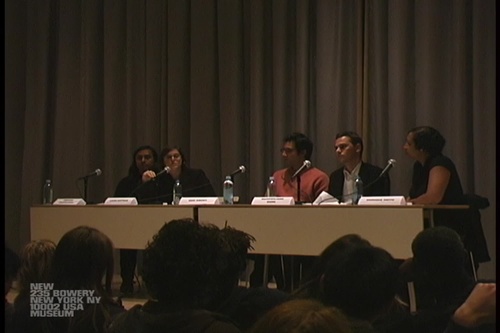
-
Ibid.
-
Shinique Smith, artist statement, 2006. New Museum Archive.
-
In 2016, American nonprofit organizations shipped 1.6 billion pounds of used clothing abroad. See “Industry Trade Data,” Secondary Materials and Recycled Textiles Association: The Association of Wiping Materials, Used Clothing and Fiber Industries, accessed January 7, 2019, https://www.smartasn.org/advocacy/industry-trade-data.
-
Gioni, “Ask the Dust,” in Unmonumental, 75.
-
“Shinique Smith,” in Unmonumental, 172.
-
“In Conversation: Yuji Agematsu with Phong Bui,” Brooklyn Rail, May 1, 2017, https://brooklynrail.org/2017/05/art/Yuji-Agematsu-with-phong-bui.
-
Extended label, “The Keeper,” 2016.
-
Yuji Agematsu, “Chewing Gum,” wall text for Yale Union, 2014.
-
Diane Waldman, “Appropriation,” in Collage, Assemblage, and the Found Object (New York: Harry N. Abrams, 1992), 188. Waldman was deputy director and senior curator at the Solomon R. Guggenheim Museum from 1982 to 1996.
-
Ibid.
-
W.J.T. Mitchell, What Do Pictures Want?: The Lives and Loves of Images (Chicago: University of Chicago Press, 2005), 114.
-
Ibid, 116.
